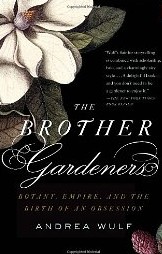 If you envy English gardeners, take a look at the entertaining yet scholarly book by Andrea Wulf that will change your thinking about plants and garden history. It tells the story of the men who brought about a revolution in gardening during the eighteenth century leading to the development of the landscape in England and eventually to the English passion for gardening. Focusing on six men, Wulf reveals the engaging tales of plant collecting, naming, and cultivation that made England a nation of gardeners.
If you envy English gardeners, take a look at the entertaining yet scholarly book by Andrea Wulf that will change your thinking about plants and garden history. It tells the story of the men who brought about a revolution in gardening during the eighteenth century leading to the development of the landscape in England and eventually to the English passion for gardening. Focusing on six men, Wulf reveals the engaging tales of plant collecting, naming, and cultivation that made England a nation of gardeners.
To appreciate the American contribution to the English garden read about the relationship between John Bartram, a Pennsylvania farmer and Peter Collinson, a London cloth merchant. They shared a love of plants and collaborated to bring the native plants of America to the gardens of England in the eighteen century. Bartram loved to explore and collect plants and Wulf brings his collecting trips to life with her descriptions of him climbing trees to collect pine cones in New Jersey and standing stranded on a ledge without his pants on during a storm. Meanwhile, Collinson spent his time growing and selling the seeds and plants provided by Bartram and together the men enabled English gardeners to make their landscape dreams into reality.
Bartram and Collinson were not the only two botanists to contribute to the English landscape. The charming Swedish botanist Daniel Solander and the wealthy English botanist Joseph Banks joined forces on two expeditions, one with Captain cook, the other with Captain Bligh, to bring more exotics home to England. According to Wulf, both of these men also helped to bring order to the chaos of the botanical world. Wulf’s narrative of these important contributions are lightened by tidbits such as the one about Banks giving his wife a piece of dried moss to wear as a bouquet and when she wouldn’t wear it he called her a “Fool that Likes diamonds better.”
The botanical world would not be the same, however, without the contributions of two other men, Carl Linnaeus, a Swedish botanist, and Philip Miller, chief gardener at the Chelsea Physic Garden who wrote a compendium of botanical knowledge. According to Wulf, Linnaeus, the man who introduced the simple system of naming living things, was both brilliant and egotistical. Linnaeus’ system met with huge opposition at the time and one of the opponents was Miller, whose influence on botany was considerable. In spite of Miller’s opposition, or perhaps because of it, according to Wulf, Linnaeus’ system was adopted and is still used today.
Although an extensively researched non-fiction book, The Brother Gardeners reads like a novel. Set against the background of the American Revolution and the wars with France, the anecdotes and tidbits about these six men and their acquaintances make very entertaining as well as informative reading. Evidence for the author’s scholarship can be seen in the extensive glossary of plants with information about their introduction, fifteen pages of bibliography, and fifty seven pages of end notes. Highly recommended for history buffs as well as gardening enthusiasts.